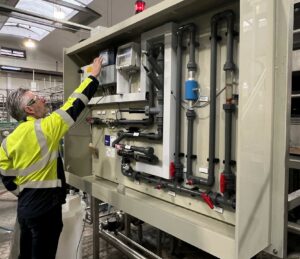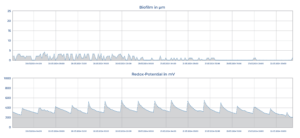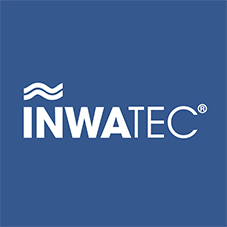Reducing the cleaning frequency in pasteurizers
Biofilm in process water and equipment can lead to a variety of problems, including clogging of pipes, corrosion of equipment and devices, and the formation of unwanted bacteria and microorganisms. It is therefore important to monitor biofilm continuous to prevent fouling and maintain process efficiency. Monitoring biofilm allows operators to take timely action to control and reduce biofilm growth. This can be done by adjusting cleaning intervals or using special cleaning agents. However, in order to keep the effort involved as low as possible, INWATEC has further developed its INWATROL expert monitoring device especially for the brewing industry and is used specifically for the treatment of pasteurizers. The most important component in the INWATROL expert series for breweries is the INWAsense biofilm sensor, which continuously monitors the biofilm. The biofilm sensor is used to quantitatively record microbial and inorganic deposits in pipes and containers through which liquid flows. The principle of the measurement is based on the reduction of the heat transfer on the pipe wall caused by the formation of a deposit.
Continuous monitoring allows trends in biofilm growth to be identified, enabling the Inwatrol Expert to take preventative action before major problems occur.
In the pasteurization process, the beer bottles are wetted with water at different heat levels. As the outside of the bottles could contain beer residue from the bottling, this beer residue enters the pasteurizer in the first heating zone of the pasteurizer. Due to the increased organic content of the beer, microorganisms can multiply particularly well and form excessive biofilms. Biofilms can clog parts of the system, resulting in inefficient pasteurization and increased cleaning effort. By monitoring the biofilm and adjusting the biocide dosage accordingly, pasteurization process is protected from these deviations and cleaning work can be massively reduced.
Overall, monitoring biofilm in process water is important to maintain process efficiency, prevent damage to equipment and ensure employee safety. Through regular monitoring, operators can take timely action to control the growth of biofilm to ensure smooth operations. In addition to quality control, breweries also face the challenge of keeping water consumption as low as possible in order to save not only the main resource, but also costs and energy. Continuous water treatment helps to reduce the number of pasteurizer cleanings required. It is worth noting that each additional cleaning involves a considerable consumption of water. The less frequent cleaning is required, the greater the amount of water saved.
Before the introduction of comprehensive water treatment, the pasteurizer cleaning in place (CIP) had to be carried out every two weeks at a brewery we visited in Belgium. Here, the pasteurizer has to be emptied and is then cleaned manually with water and a cleaning solution. The pasteurizer is then boiled out with water and caustic soda to remove all remaining biofilm residues followed by rinsing with clear water and refilled. This process costs time, water, energy and production time. By using the INWATROL expert for breweries, the cleaning interval could be extended to more than eight weeks. This practical example illustrates the vital importance and numerous benefits of comprehensive water treatment in breweries.

By dosing our chlorine dioxide-based biocide INWASAN, it is possible to penetrate the biofilm and impede its growth in the pasteurizer. Chlorine dioxide is a strong oxidizing agent that has an antimicrobial effect on biofilm. It works by attacking and destroying the cell membranes of bacteria and other microorganisms. This kills the organisms and destabilizes the biofilm. The effectiveness of chlorine dioxide against biofilms depends on various factors, such as the concentration of the chlorine dioxide, the exposure time and the temperature. Through targeted dosing and application, chlorine dioxide can effectively help to control biofilm and reduce the growth of unwanted microorganisms.
By measuring the biofilm online and continuously measuring the thickness of the biofilm, the biocide INWASAN can be dosed depending on the thickness of the biofilm. The INWATROL expert is programmed to dose either more or less biocide depending on the biofilm thickness in order to remove the biofilms. The dosing success is monitored by an additional built-in redox potential probe. As chlorine dioxide has an oxidizing effect, the redox potential, measured in mV, increases and generates a so-called “peak”. Measuring this peak therefore ensures that sufficient biocide is present. By measuring the biofilm at the same time, you can also see whether the dosage was sufficient.
Due to the connected online monitoring, the dosage can also be adjusted remotely.

In addition to microbiological control, the INWATROL expert is also used in breweries to inhibit corrosion of crown caps and cans. Corrosion and microbiology do not necessarily play a joint role in pasteurization. At this point, it is primarily a matter of protecting the grain corks from corrosion. Water in its pure form can already trigger corrosion without the use of corrosion inhibitors. As the bottles from the pasteurizer are not dried separately, a film of water remains on the crown corks. This can promote corrosion on the crown corks. As an oxidizing biocide (INWASAN) is also used in the pasteurizer, this can also promote corrosion on crown corks. Due to the precise dosing of the corrosion protection, the dosing is carried out exactly and there is no under- or overdosing. This also takes place via an online measurement in the INWATROL expert, which measures the concentration of the corrosion protection directly in the water. After the pasteurization process, the corrosion protection remains in the water film on the crown cork and forms a protective layer so that no corrosion attack can take place.











